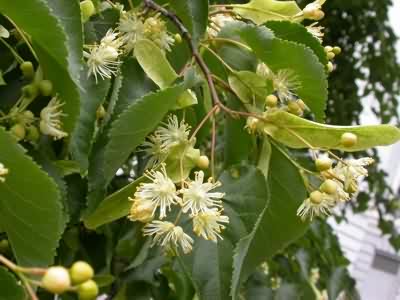Relatives
Tilia cordata Mill. s.str. - Small-leaved Lime, Small-leaved Linden.
Taxonomic position.
Family Tiliaceae Juss. genus Tilia L.Morphology and biology.
Deciduous tree up to 30 mm tall with broad crown and glossy, red or oliveaceous shoots. Branches strong, young ones distinctly zigzag-shaped. Leaves alternate, broadly cordate, with acuminate apex and deeply cordate base, finely serrate at margin. Flowers aggregated in leaf axils in corymbose inflorescences, bearing a large tongue-shaped bract at base. Flowers about 1 cm diameter, inconspicuous, yellowish-white with very strong honey fragrance. Fruit is a nutlet, subglobose, usually densely pubescent.Entomophilous. Propagates by summer cuttings and seeds. Flowers in June - July, mature fruits in late September - early October. 2n=82.
Distribution.
Europe; European Russia (except for extreme North and Northeast); Central and South Urals; montane Crimea; Caucasus (central Ciscaucasia, Dagestan, Eastern and Southern Transcaucasia); West Siberia (the Konda, Noska, Tavda river basins, lower and partly middle courses of the Irtysh, Tobol, Ishim Rivers, isolated locality at Medvezhye Lake).Ecology.
Mesophyte. Shade-resistant. One of main forest-forming species in broad-leaved forests. Forms pure stands, especially on slopes of river valleys, or together with other broad-leaved trees. In the north and east of its range, it occurs as a component of coniferous-broad-leaved forests, at the range border occurs only as admixture in coniferous forests.Use and economic value.
Technical, medicine, ornamental. Valuable tree species with soft wood, used to make cookwares, toys, musical instruments etc. Bast is used for matting, in the past was used for bast shoes (larti) and ropes. Flowers with bracts are used in both official and folk medicine as antiphlogistic, diuretic, diaphoretic, analgesic, nervine mean. Lime is one of the best honey plants; lime honey has sedative effect.References:
Gubanov IA., Kiseleva KV., Novikov VS., Tikhomirov VN. 2003. Illustrated Manual of the Middle Russia Plants. V.2. Moscow: KMK. 665 p. (In Russian).Koropachinskiy IYu., Vstovskaya TN. 2002. Woody plants of the Asian part of Russia. Novosibirsk: Publishing House of Siberian Division of the Russian Academy of Science, Branch "Geo". P.496-497. (In Russian).
Sokolov SI., Svjaseva OA., Kubli VA. 1986. Ranges of trees and shrubs of the USSR. V.3. Leningrad: Nauka. P.86-87. (In Russian).


